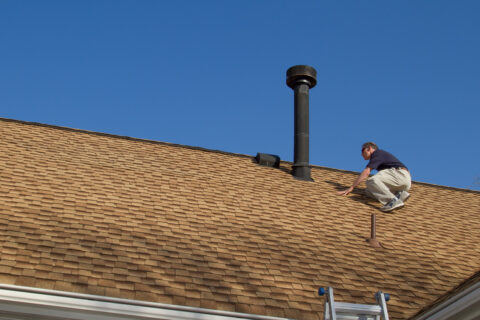 Your roof’s function is to protect your home and its contents from the elements. Sometimes this protection comes at a price: the roof may suffer damage that will limit its ability to protect your home now or in the future.
Your roof’s function is to protect your home and its contents from the elements. Sometimes this protection comes at a price: the roof may suffer damage that will limit its ability to protect your home now or in the future.
The sooner you detect this damage, the sooner you can repair it and ensure your roof is able to protect your home from future damage. Here are some techniques you can use to find roof damage.
Look at Your Ceiling
You can start looking for roof damage without even leaving your house. Start by walking from room to room and looking at the ceilings for water damage. Signs of water damage on your ceiling include:
- Discoloration
- Sagging or bulging
- Bubbling paint
- Detached or falling coating
- Cracking
- Mold growth
Water damage in the ceiling is almost always a sign of roof damage.
Sometimes, water damage doesn’t manifest on the ceilings of your highest floor. Water can flow along the house structure and inside walls before becoming visible. Check the ceilings of lower floors and look for water damage to the walls as well.
Inspect the Attic
 A lack of water damage to your ceiling doesn’t mean you don’t have roof damage, it just means that roof damage hasn’t caused visible water damage yet. Your next step is to go into your attic and look for signs of water.
A lack of water damage to your ceiling doesn’t mean you don’t have roof damage, it just means that roof damage hasn’t caused visible water damage yet. Your next step is to go into your attic and look for signs of water.
Make sure you have adequate light, including a beam that you can use to shine at different angles to catch the reflectiveness of wet surfaces. Also look for signs of mold or mildew. This might be dark brown, black, or white growth on the wood framing. Also look for wood that is crumbling, cracking, or powdering. Check insulation for wetness and damage, such as compression or displacement by water.
If you do detect signs of water, try to track it back to its source. Rainwater will always flow downward, so trace its path upward until you find a likely culprit for the leak.
Check the Downspouts
If your attic seems secure from water, it’s time to check for signs of damage that might not yet be causing a leak but could in the future. One place to start is by looking at what’s washed out of your downspouts.
You should expect to see a lot of granules from asphalt shingles, especially if they’re new, but you should be concerned if you see other types of debris, such as pieces of asphalt backing, parts of wooden shakes, ceramic tile pieces, or screws, nails, and other hardware.
Look at the Roof from a Distance
Before giving your roof a close inspection, take a moment to look at it from a distance. Sometimes problems can be visible from a distance.
Make sure the lines of the roof are all straight. Any sagging or curving of the roof is a cause for concern. For example, a large branch might have fallen on the roof, causing damage. Even if the branch eventually fell off, the damage remains. Left unrepaired, this damage could lead to additional problems, including a collapsed roof.
Look for missing shingles, shakes, or tiles. Check for dark spots. Look to see if the paint is blistering or peeling. If you see roof problems, you should call for a professional inspection.
Get on the Roof

When you are up on the roof or looking with binoculars, check for damaged shingles. Hail damage, for example, is highly visible as an indentation into the shingle, typically with a significant loss of roofing granules. Granules protect the shingles from sunlight, and once they’re gone the shingles can begin to degrade rapidly.
Also look at the roof vents and vent boots to make sure they are still stable and properly sealed all around. Also look at flashing – the metal pieces that protect the areas where horizontal and vertical surfaces meet on the roof. The flashing should be secure and provide complete coverage for the entire surface where water might flow. If you have places where the roof meets a wall, make sure the flashing is high enough and you don’t have signs of water damage over the flashing as well.
Repairs for Roof Damage in your area
If your roof has suffered damage in a storm, let your local FLEET company help. As the leading restoration company in your area since 1954, we have helped many homeowners get their roofs back into peak condition after major and minor storm damage.
We offer 24/7 emergency response services, so you can call us any time, day or night, to deal with your storm damaged roof. The restoration experts at your local FLEET company will arrive on the scene and immediately get to work. Unlike some specialists, we can handle every aspect of roof damage restoration. This includes not just storm damage restoration for the roof, but also water damage restoration if water penetrated the house and damaged its structure or contents.
your local FLEET company works with insurance every day, and we can coordinate your claim for a speedy and convenient process. We understand their requirements for filing a successful claim. We will thoroughly document the damage and all the repairs to meet your insurer’s strict standards. Your claim won’t be denied or delayed because of inadequate documentation.
To learn how your local FLEET company can help with your roof repairs, please contact us at 844-967-4911 today. We serve customers in your area.
